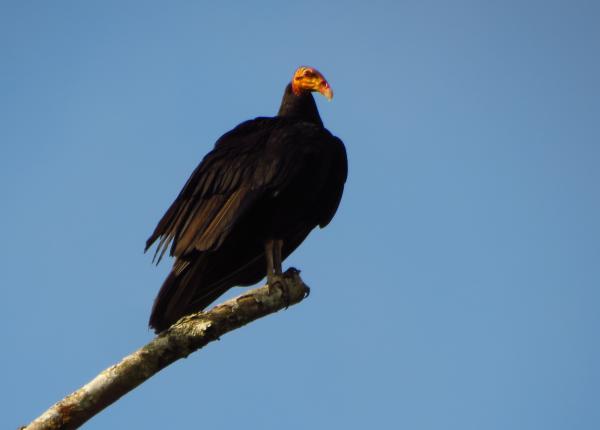Did You Know?
- The Greater Yellow-headed Vulture was first described as a species in 1964! This was because, up until then, it had been lumped together with the very similar Lesser Yellow-headed Vulture
How The Peregrine Fund is Helping
Though The Peregrine Fund doesn't work directly with Greater Yellow-headed Vultures, we do work with a number of vulture species around the world. In the Americas, we work directly with both California and Andean Condors. We participate in Vulture Awareness Day, and our efforts in scientific research, habitat conservation, education, and community development help conserve raptors around the world. We also supply literature to researchers from our avian research library, which helps scientists the world over gather and share important information on raptor conservation. Our work with the Neotropical Raptor Network helps conserve raptors by fostering collaboration and communication among raptor enthusiasts in the region. And, finally, our support of the Global Raptor Information Network gives raptor researchers tools to more efficiently conduct their own studies while contributing to a global program. It also provides citizen scientists a way to participate in raptor science and conservation.
Where They Live
The Greater Yellow-headed Vulture is found throughout portions of South America. It spends its time soaring and foraging in lowlands and in mature forest. Its range generally doesn't overlap with other Cathartes species, such Lesser Yellow-headed Vulture and Turkey Vulture. Also, unlike the Turkey and Lesser Yellow-headed Vultures, it flies with its wings held horizontally, and not in dihedral (or v-shaped). It can often be seen perching on exposed branches of high trees or snags at edge of forest, often in small groups.
Why They Need our Help
Common in undisturbed lowland tropical forests of the Amazonian region. Vulnerable to forest destruction and heavy hunting pressure, which could affect its food base. Schlee (2000) recommended that this species be placed on CITES II, but this conservative view does not coincide with that of Márquez Reyes et al. (2000) or other recent authors. Regarded as a species of "Least Concern" by BirdLife International
What They Eat
Feeds solely on carrion, especially of forest mammals, including monkeys, sloths, and opossums, and also on dead fish (Robinson 1994). In Peru, it soars fairly low (<100 m) over the canopy and open areas, finding small carcasses inside the forest and along watercourses (Robinson 1994). Like the other Cathartes species, these vultures locate food items by olfactory and visual cues
Nests, Eggs, and Young
Scientists know very little about the breeding habits of the Greater Yellow-headed Vulture. Like many other vulture species, it nests in large natural tree cavity. The female usually lays 2 eggs.
Greater Yellow-headed Vulture and the World Center for Birds of Prey
The World Center for Birds of Prey offers fun ways to learn about raptors. Interactive activities, tours, interesting videos and a children's room with activities from coloring sheets and quizzes to costumes and a touch table are available for the curious mind. We also have several different birds of prey on display year-round, including several vulture species! Though we don't have any resident GreaterYellow-headed Vultures at the World Center for Birds of Prey, if you visit you will be rewarded with an opportunity to meet our resident Turkey Vulture, who is a close cousin of the Greater Yellow-headed Vulture. At the visitor center, you will see this lovely bird of prey up close in our outdoor aviary. We also have several California Condors on display. Come learn about these unique species.
References:
Global Raptor Information Network. 2021. Species account: Greater Yellow-headed Vulture Cathartes melambrotus. Downloaded from http://www.globalraptors.org on 23 Sep. 2021
Jones, M. F. (2020). Greater Yellow-headed Vulture (Cathartes melambrotus), version 1.0. In Birds of the World (T. S. Schulenberg, Editor). Cornell Lab of Ornithology, Ithaca, NY, USA. https://doi.org/10.2173/bow.gyhvul1.01









